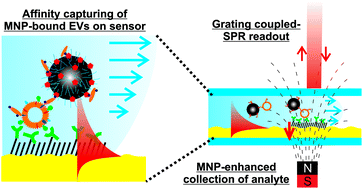Our official English website, www.x-mol.net, welcomes your
feedback! (Note: you will need to create a separate account there.)
Magnetic nanoparticle-enhanced surface plasmon resonance biosensor for extracellular vesicle analysis
Analyst ( IF 3.6 ) Pub Date : 2017-08-24 00:00:00 , DOI: 10.1039/c7an00469a Agnes T. Reiner 1, 2, 3, 4, 5 , Nicolas-Guillermo Ferrer 1, 2, 3, 4 , Priyamvada Venugopalan 1, 2, 3, 4 , Ruenn Chai Lai 5, 6, 7 , Sai Kiang Lim 5, 6, 7 , Jakub Dostálek 1, 2, 3, 4
Analyst ( IF 3.6 ) Pub Date : 2017-08-24 00:00:00 , DOI: 10.1039/c7an00469a Agnes T. Reiner 1, 2, 3, 4, 5 , Nicolas-Guillermo Ferrer 1, 2, 3, 4 , Priyamvada Venugopalan 1, 2, 3, 4 , Ruenn Chai Lai 5, 6, 7 , Sai Kiang Lim 5, 6, 7 , Jakub Dostálek 1, 2, 3, 4
Affiliation

|
The sensitive analysis of small lipid extracellular vesicles (EVs) by using a grating-coupled surface plasmon resonance (GC-SPR) biosensor has been reported. In order to enable the analysis of trace amounts of EVs present in complex liquid samples, the target analyte is pre-concentrated on the sensor surface by using magnetic nanoparticles and its affinity binding is probed by wavelength interrogation of SPR. The GC-SPR has been demonstrated to allow for the implementation of efficient pulling of EVs to the sensor surface by using magnetic nanoparticles and an external magnetic field gradient applied through the sensor chip. This approach overcomes slow diffusion-limited mass transfer and greatly enhances the measured sensor response. The specific detection of different EV populations secreted from mesenchymal stem cells is achieved with a SPR sensor chip modified with antibodies against the surface marker CD81 and magnetic nanoparticles binding the vesicles via annexin V and cholera toxin B chain.
中文翻译:

磁性纳米颗粒增强的表面等离子体共振生物传感器用于细胞外囊泡分析
据报道,通过使用光栅耦合表面等离振子共振(GC-SPR)生物传感器对小脂质细胞外囊泡(EVs)的灵敏分析。为了能够分析复杂液体样品中存在的痕量EV,通过使用磁性纳米颗粒将目标分析物预浓缩在传感器表面,并通过SPR的波长询问探测其亲和力。GC-SPR已被证明可以通过使用磁性纳米颗粒和通过传感器芯片施加的外部磁场梯度来实现将EV高效地拉至传感器表面。这种方法克服了缓慢的扩散限制的质量传递,并大大增强了测得的传感器响应。通过膜联蛋白V和霍乱毒素B链。
更新日期:2017-09-18
中文翻译:

磁性纳米颗粒增强的表面等离子体共振生物传感器用于细胞外囊泡分析
据报道,通过使用光栅耦合表面等离振子共振(GC-SPR)生物传感器对小脂质细胞外囊泡(EVs)的灵敏分析。为了能够分析复杂液体样品中存在的痕量EV,通过使用磁性纳米颗粒将目标分析物预浓缩在传感器表面,并通过SPR的波长询问探测其亲和力。GC-SPR已被证明可以通过使用磁性纳米颗粒和通过传感器芯片施加的外部磁场梯度来实现将EV高效地拉至传感器表面。这种方法克服了缓慢的扩散限制的质量传递,并大大增强了测得的传感器响应。通过膜联蛋白V和霍乱毒素B链。











































 京公网安备 11010802027423号
京公网安备 11010802027423号